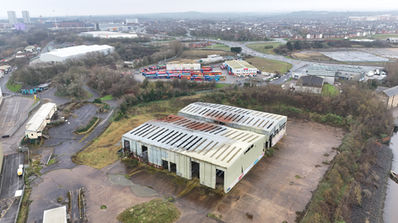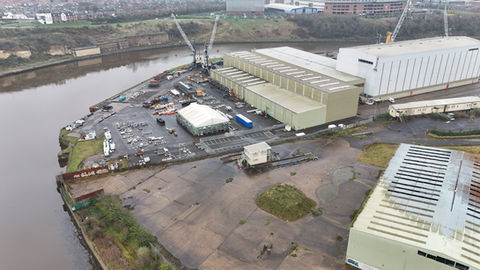SUN030
Wear
Deptford
Laing Shipyard, Deptford
Sunderland
54.915680, -1.397826
Useful Links:
Opened:
1818
Closed:
1986
Owners:
Philip Laing (1818 - 1843), Thomas Simey (1834 - 1837) James Laing (1844 - 1898), Sir James Laing & Sons Ltd. (1898 - 1965), Doxford & Sunderland Shipbuilding & Engineering Co Ltd. (1966 - 1977), British Shipbuilders (1977 - 1986)
Types built here:
Customers (Not Exhaustive):
Estimated Output:
700
Construction Materials:
Wood, Iron, Steel
Status:
Redeveloped
Created:
Last Updated:
14/05/25
12/06/25
Description
One of the most prolific and longest serving yards on the Wear was the Laing complex at Deptford. The Laing's had originally migrated down from Scotland in the 1780s, setting up a shipyard on the North Sands in the 1790s. Various splinters of the family meant they ran a few seperate yards on the Tyne and the Wear in the early 19th century. On this river they occupied both sides, including at Southwick and Monkwearmouth. Philip, the founder of the Deptford yard, previously worked at the Southwick and Monkwearmouth Bridge yard, but Philip acquired Deptford House in 1818.
The first known ship to be built here was the Edgar, a snow in 1819 for himself. The Laing's were an entrepreneurial bunch and operated as much of the supply chain as they could - from constructing the ships to transporting the goods, driving down costs and leveraging their own control over the trade. He did also make vessels for nationally recognised merchants and organisations too.
For a short period, Philip went into partnership with Thomas Simey in the mid 1830s. Thomas had his own slipway at The Strand before entering partnership with the Laing's, and his son also operated at Strand Street until the late 1870s. It was short lived however, and Philip returned to operating independently until 1843. He passed the business down to his only son James due to retirement, whose ships began to be registered in his name from 1843. It was short into James' tenure when the Wear's first iron ship, the Amity, was constructed in 1853.
It was at this stage we get our first glimpse of the yard on the Ordnance Survey maps. We see the extensive patent slipway which extends on a 15 degree angle north westwards, with a smithy and sawpit adjacent to Deptford House where Laing resided. Great housing developments cropped up around this time at Deptford too, no doubt accommodating the hundreds of workers who ended up crafting the vessels here. At this time Deptford was divided by the Saltgrass Dock - later infilled to expand Laing's yard to encompass the full head of the peninsula.
James continued constructing wooden ships alongside iron and steel for some time. Composite ships were also constructed. The reputation of the firm went international in the latter half of the 19th century with carriers, tankers and passenger ships constructed for firms in Greece, Canada, South Africa, Germany, the Caribbean and Mexico. This is alongside local colliers for the Earl of Durham and the Marquess of Londonderry, as well as household names still operating like P&O and the old Royal Mail steam packets.
The the 1890s there were 3 slipways and the original gracing dock, probably alongside some other building berths along the quay side. The firm was incorporated as a limited liability company in 1898, just after James Laing was knighted. James, by his death in 1901, had ran the company for 58 years and for the 7 or 8 years after the business was in financial difficulty. Though orders continued to roll in from various international merchants, it was modernisation and the First World War that really strengthened the firm. Sir James Marr took over just before 1910, and in WWII the yard produced the greatest amount of tonnage on the whole river. Though they did not construct warships, they amassed a great portfolio of tankers, coasters and cargo ships for the government who issued contracts at the time. There were 18 built across the war, totalling nearly 110,000 tons. By this time there were 5 building berths and a graving dock.
The Great Depression again hit the yard, though the same cycle of bust and boom occurred again with the Second World War. They were again prolific builders for the Shipping Controller, predominantly tankers which they became known for, producing 41 vessels. From there they specialised in these tankers as well as bulk carriers. Orders steadily continued for international cargo companies for the next couple of decades.
Independence of the yard ceased after 1966, having already become a subsidiary of the Sunderland Shipbuilders in the mid 1950s. The whole of the Wear struggled by this time, so efforts were made to amalgamate the Doxford yards among others at Deptford, Pallion and the North Sands. It was eventually nationalised in 1977 under British Shipbuilders, who managed to scrape together business until 1986. Today, the mouth of the graving dock can still be seen but little else as the site is still dormant.


Ordnance Survey, 1890s
Have we missed something, made a mistake, or have something to add? Contact us
Historic Environment Records
Durham/Northumberland: Keys to the Past
Tyne and Wear: Sitelines
HER information as described above is reproduced under the basis the resource is free of charge for education use. It is not altered unless there are grammatical errors.
Historic Maps provided by









